brake fluid CHEVROLET CORVETTE 1995 4.G Owners Manual
[x] Cancel search | Manufacturer: CHEVROLET, Model Year: 1995, Model line: CORVETTE, Model: CHEVROLET CORVETTE 1995 4.GPages: 386, PDF Size: 20.15 MB
Page 186 of 386
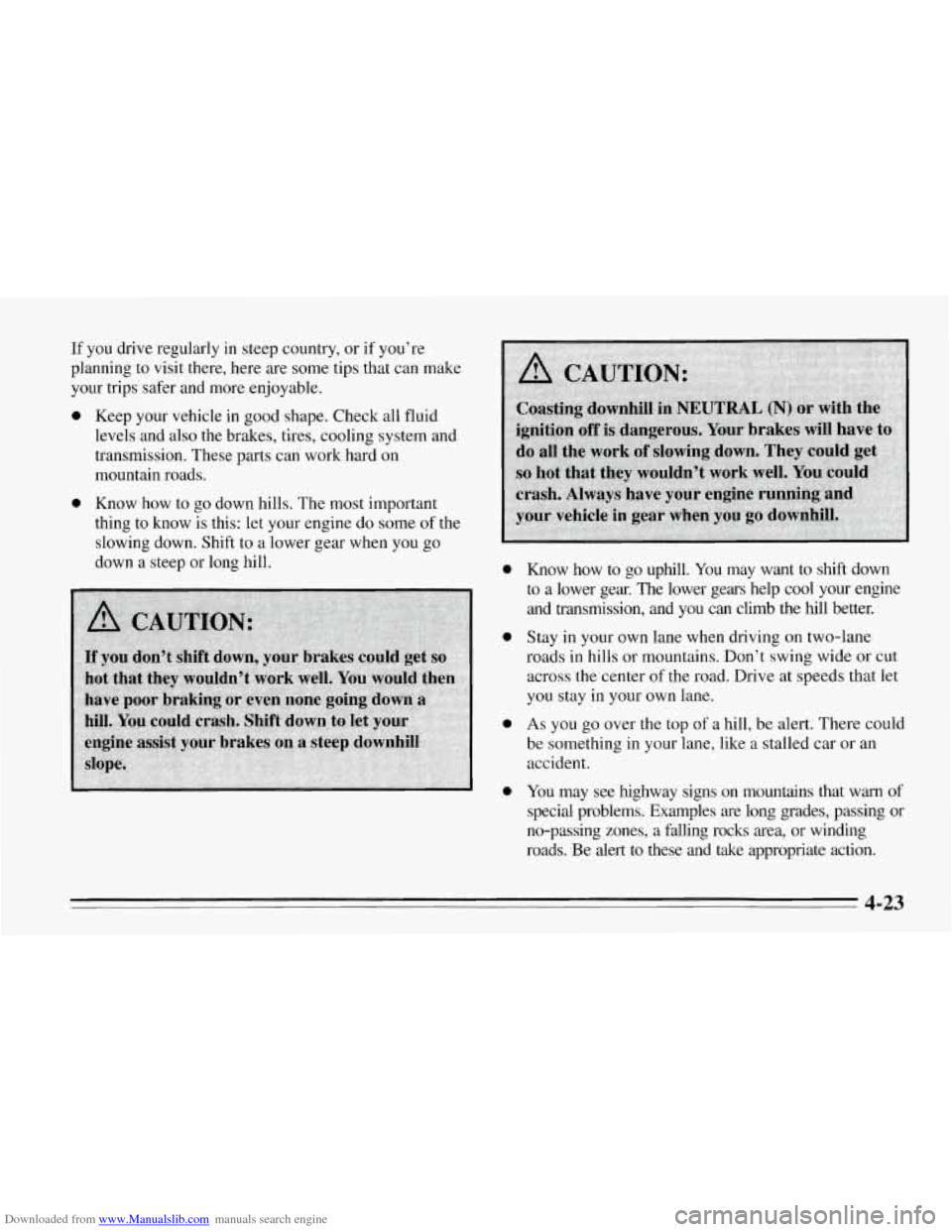
Downloaded from www.Manualslib.com manuals search engine If you drive regularly in steep country, or if you’re
planning to visit there, here are some tips that can make
your trips safer and more enjoyable.
0 Keep your vehicle in good shape. Check all fluid
levels and also the brakes, tires, cooling system and
transmission. These parts can work hard on
mountain roads.
0 Know how to go down hills. The most important
thing
to know is this: let your engine do some of the
slowing down. Shift
to a lower gear when you go
down a steep or long hill. 0 Know how to go uphill. You may want to shift down
0
0
0
to a lower gear. The lower gears help cool your engine
and transmission, and you can climb the hill better.
Stay in your own lane when driving on two-lane
roads
in hills or mountains. Don’t swing wide or cut
across the center of the road. Drive at speeds that let
you stay in your own lane.
As you go over the top of a hill, be alert. There could
be something in your lane, like a stalled car
or an
accident.
You may
see highway signs on mountains that warn of
special problems. Examples are long grades, passing
or
no-passing zones, a falling rocks area, or winding
roads. Be alert to these
and take appropriate action.
4-23
Page 244 of 386

Downloaded from www.Manualslib.com manuals search engine You’ll see the following when you open the hood with
the
LTl engine:
1.
2.
3.
4.
5.
6.
7.
8.
9.
10.
11.
12.
Hydraulic Clutch Fluid Reservoir (if equipped)
Brake Fluid Reservoir
Battery
Electric Engine Fan
Air Cleaner
Coolant Recovery Tank Power Steering Fluid Reservoir
Engine Oil Fill Cap
Engine Oil Dipstick Windshield Washer Fluid Reservoir
Coolant High
Fill Reservoir
Automatic Transmission Dipstick (if equipped)
6-9
Page 245 of 386
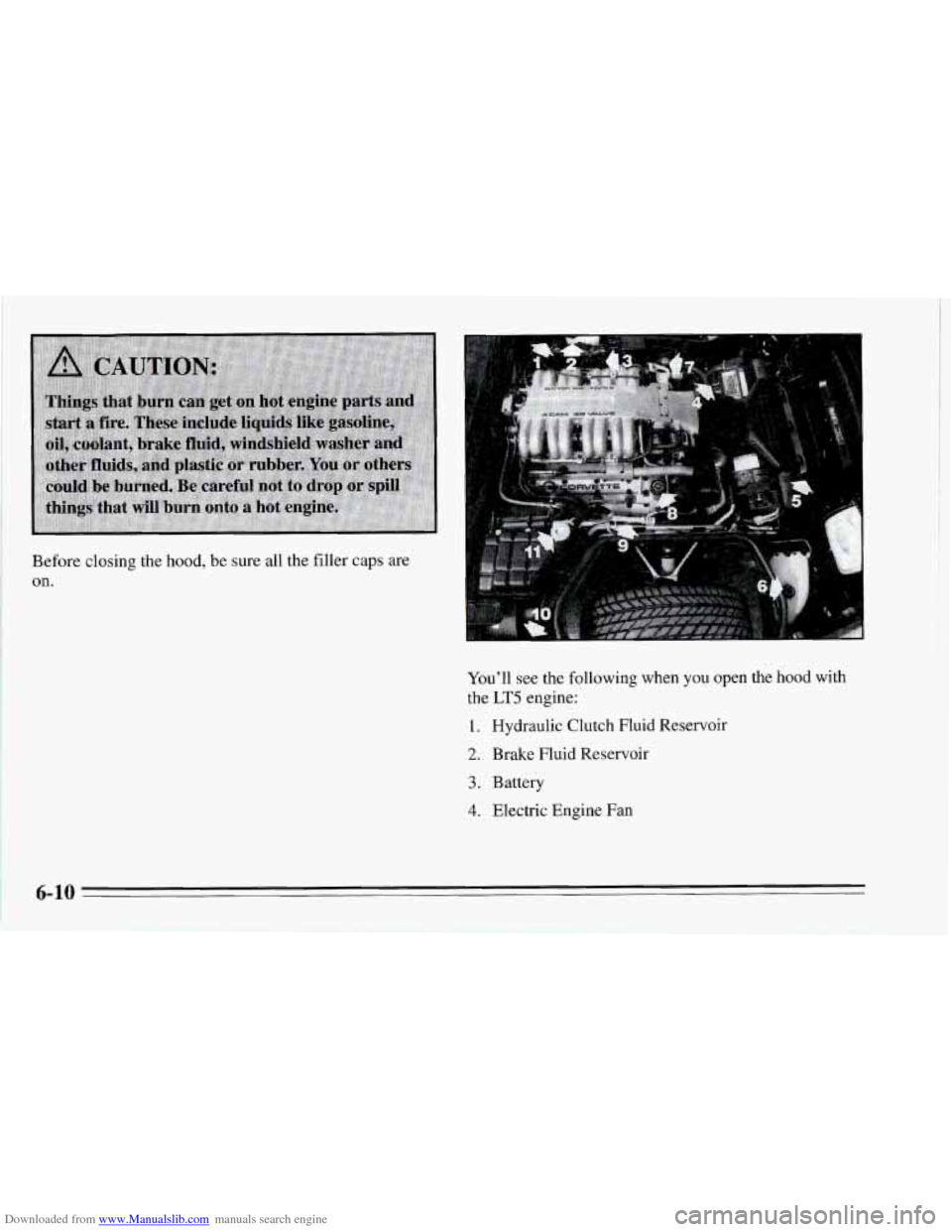
Downloaded from www.Manualslib.com manuals search engine Before closing the hood, be sure all the filler caps are
on.
You’ll see the following when you open the hood with
the
LT5 engine:
1. Hydraulic Clutch Fluid Reservoir
2. Brake Fluid Reservoir
3. Battery
4. Electric Engine Fan
6-10
Page 256 of 386

Downloaded from www.Manualslib.com manuals search engine Wait at least 30 minutes before checking the
transmission fluid level if you have been driving:
When outside temperatures are above 90°F (32°C).
At high speed for quite a while.
In heavy traffic -- especially in hot weather.
To get the right reading, the fluid should be at normal
operating temperature, which is
1 80°F to 200°F (82 "C
to 93 " C).
To check transmission fluid hot: Get the vehicle
warmed up by driving about
15 miles (24 km) when
outside temperatures are above 50°F
(10°C). You may
have to drive longer to bring the fluid to 180°F to
200" F
(82°C to 93 "C) in colder outside temperatures. See
"Automatic Transmission Fluid Temperature Reading"
in the Index.
To check transmission fluid cold: A cold check is
made after the vehicle has been sitting for eight hours or
more with the engine off and is used only as a reference.
Let the engine run at idle for five minutes if outside
temperatures are
50°F (10°C) or more. If it's colder
than
50°F (IOOC), you may have to idle the engine
longer. Should the fluid level be low during a cold
check, you
must perform a hot check before adding
fluid. This will give you
a more accurate reading of the
fluid level.
To check the fluid hot or cold
Park your vehicle on a level place. Keep the engine
running.
in PARK (P).
With the parking brake applied, place the shift lever
With your foot on the brake pedal, move the shift
lever through each gear range, pausing for about
three seconds in each range. Then, position the shift
lever in PARK (P).
Let the engine run at idle for three minutes or more.
Then, without shutting off the engine, follow these steps:
1. Pull out the dipstick and wipe it with a clean rag or
paper towel.
6-21
Page 267 of 386
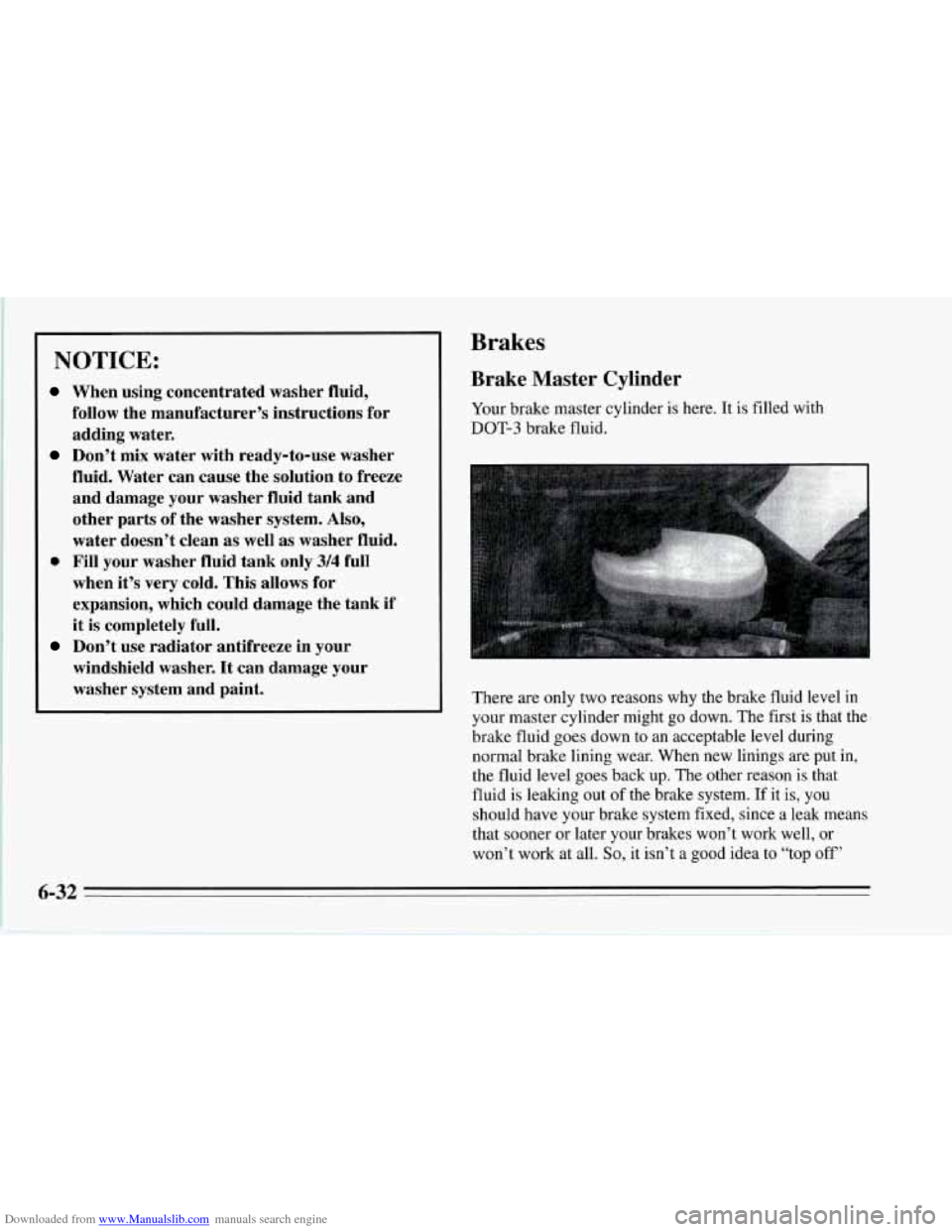
Downloaded from www.Manualslib.com manuals search engine NOTICE:
When using concentrated washer fluid,
follow the manufacturer’s instructions for
adding water.
Don’t mix water with ready-to-use washer
fluid. Water can cause the solution to freeze
and damage your washer fluid tank and
other parts of the washer system. Also,
water doesn’t clean as well
as washer fluid.
0 Fill your washer fluid tank only 3/4 full
when it’s very cold. This allows for
expansion, which could damage the tank if
it is completely full.
windshield washer.
It can damage your
washer system and paint.
Don’t use radiator antifreeze in your
Brakes
Brake Master Cylinder
Your brake master cylinder is here. It is filled with
DOT-3 brake fluid.
There are only two reasons why the brake fluid level in
your master cylinder might go down. The first is that the
brake fluid goes down to an acceptable level during
normal brake lining wear. When new linings are put in,
the fluid level goes back up. The other reason is that
fluid is leaking out
of the brake system. If it is, you
should have your brake system fixed, since a leak means
that sooner
or later your brakes won’t work well, or
won’t work at all.
So, it isn’t a good idea to “top off’
6-32
Page 268 of 386
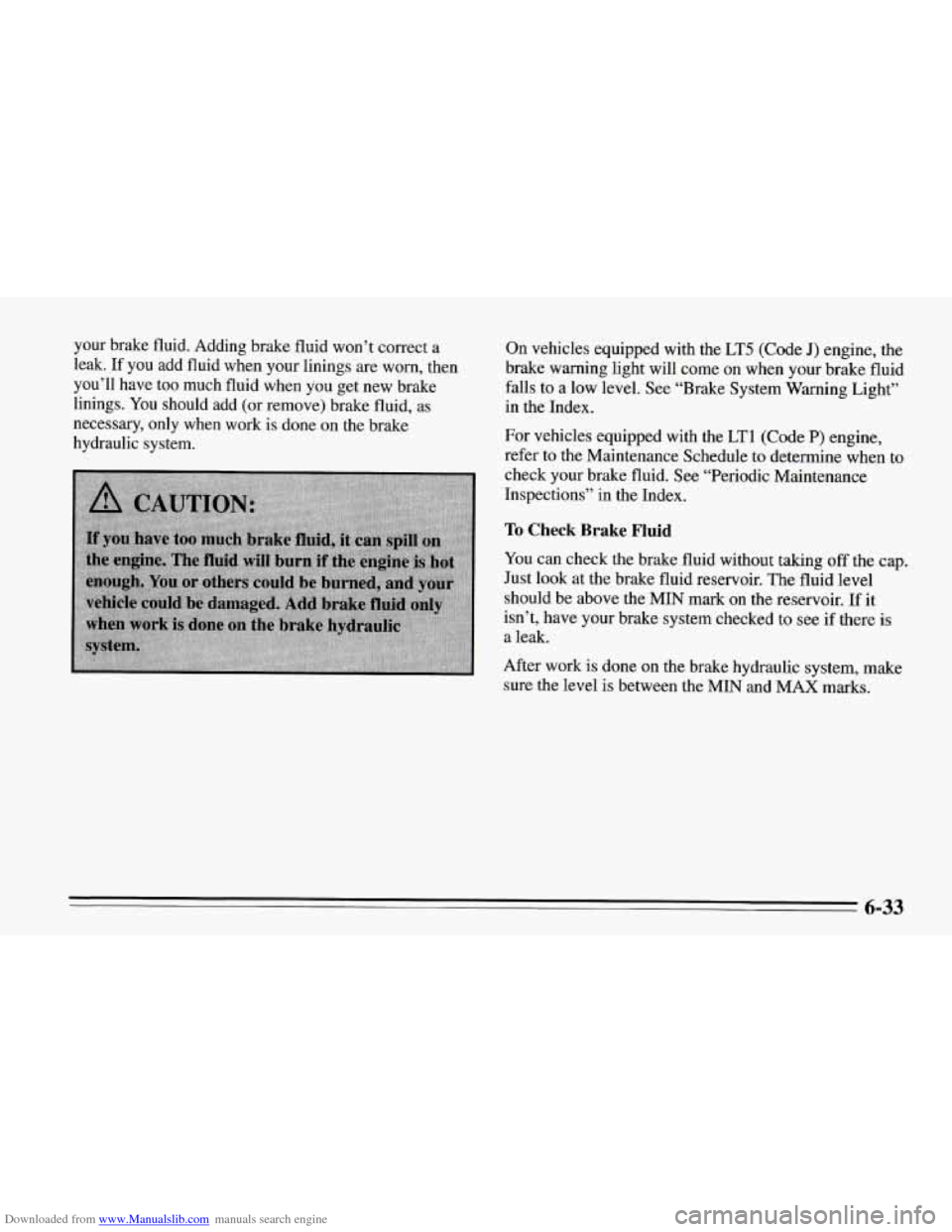
Downloaded from www.Manualslib.com manuals search engine your brake fluid. Adding brake fluid won’t correct a
leak. If you add fluid when your linings
are worn, then
you’ll have too much fluid when
you get new brake
linings. You should add (or remove) brake fluid, as
necessary, only when work is done on the brake
hydraulic system. On
vehicles equipped with the
LT5 (Code J) engine, the
brake warning light will come on when your brake fluid
falls to a low level. See “Brake System Warning Light”
in the Index.
For vehicles equipped with the
LT1 (Code P) engine,
refer to the Maintenance Schedule to determine when to
check your brake fluid. See “Periodic Maintenance
Inspections” in the Index.
To Check Brake Fluid
You can check the brake fluid without taking off the cap.
Just look at the brake fluid reservoir.
The fluid level
should be above the MIN mark on the reservoir. If it
isn’t, have your brake system checked to see
if there is
a leak.
After work is done on the brake hydraulic system, make
sure the level is between the MIN and MAX
marks.
6-33
Page 269 of 386
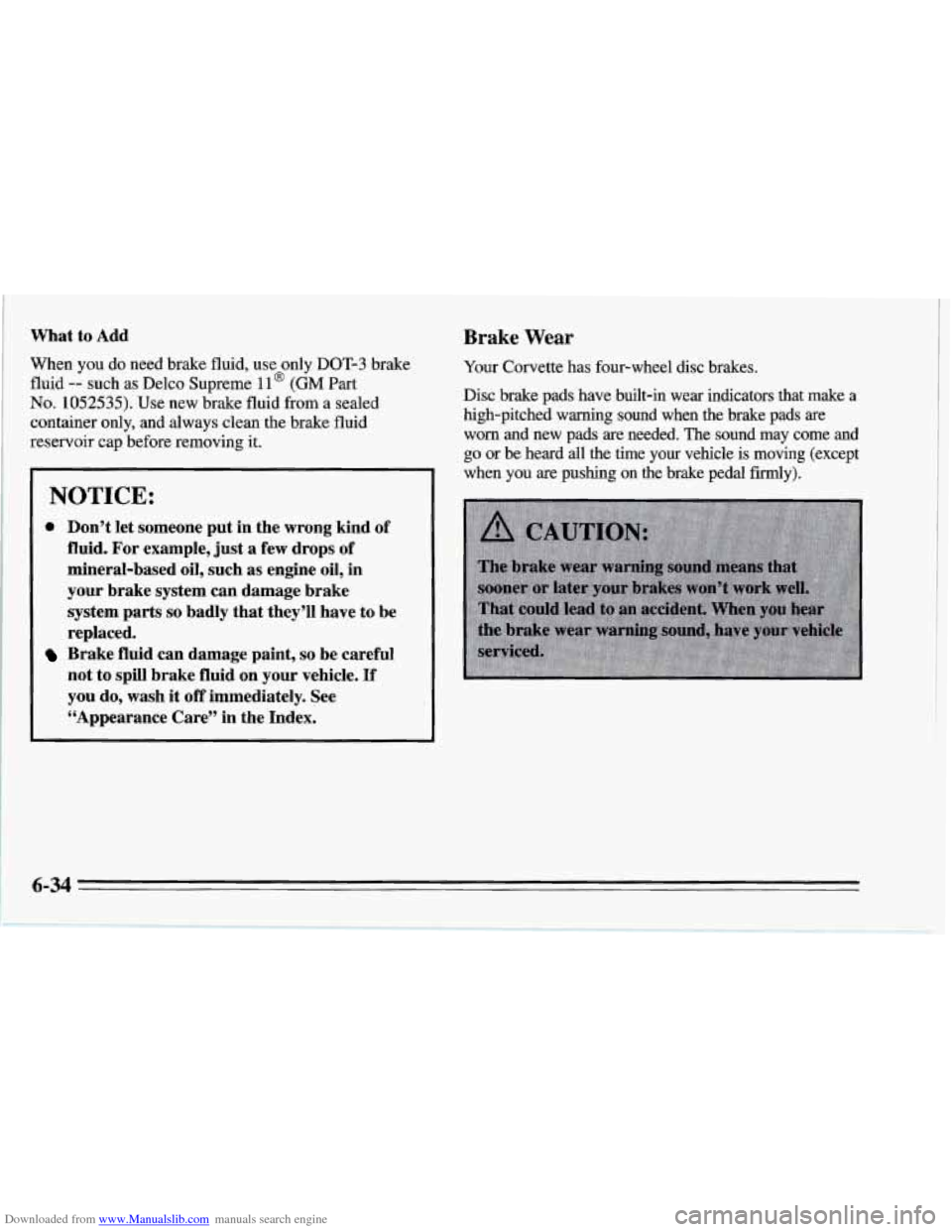
Downloaded from www.Manualslib.com manuals search engine What to Add
When you do need brake fluid, use only DOT-3 brake
fluid
-- such as Delco Supreme ll@ (GM Part
No. 1052535). Use new brake fluid from a sealed
container only, and always clean the brake fluid
reservoir cap before removing it.
NOTICE:
0 Don’t let someone put in the wrong kind of
fluid. For example, just
a few drops of
mineral-based oil, such as engine oil, in
your brake system can damage brake
system parts
so badly that they’ll have to be
replaced.
Brake fluid can damage paint, so be careful
not to spill brake fluid on your vehicle.
If
you do, wash it off immediately. See
“Appearance Care” in the Index.
Brake Wear
Your Corvette has four-wheel disc brakes.
Disc brake pads have built-in wear indicators that make
a
high-pitched warning sound when the brake pads are
worn and new pads are needed. The sound may come
and
go or be heard all the time your vehicle is moving (except
when you are pushing
on the brake pedal firmly).
6-34
Page 327 of 386
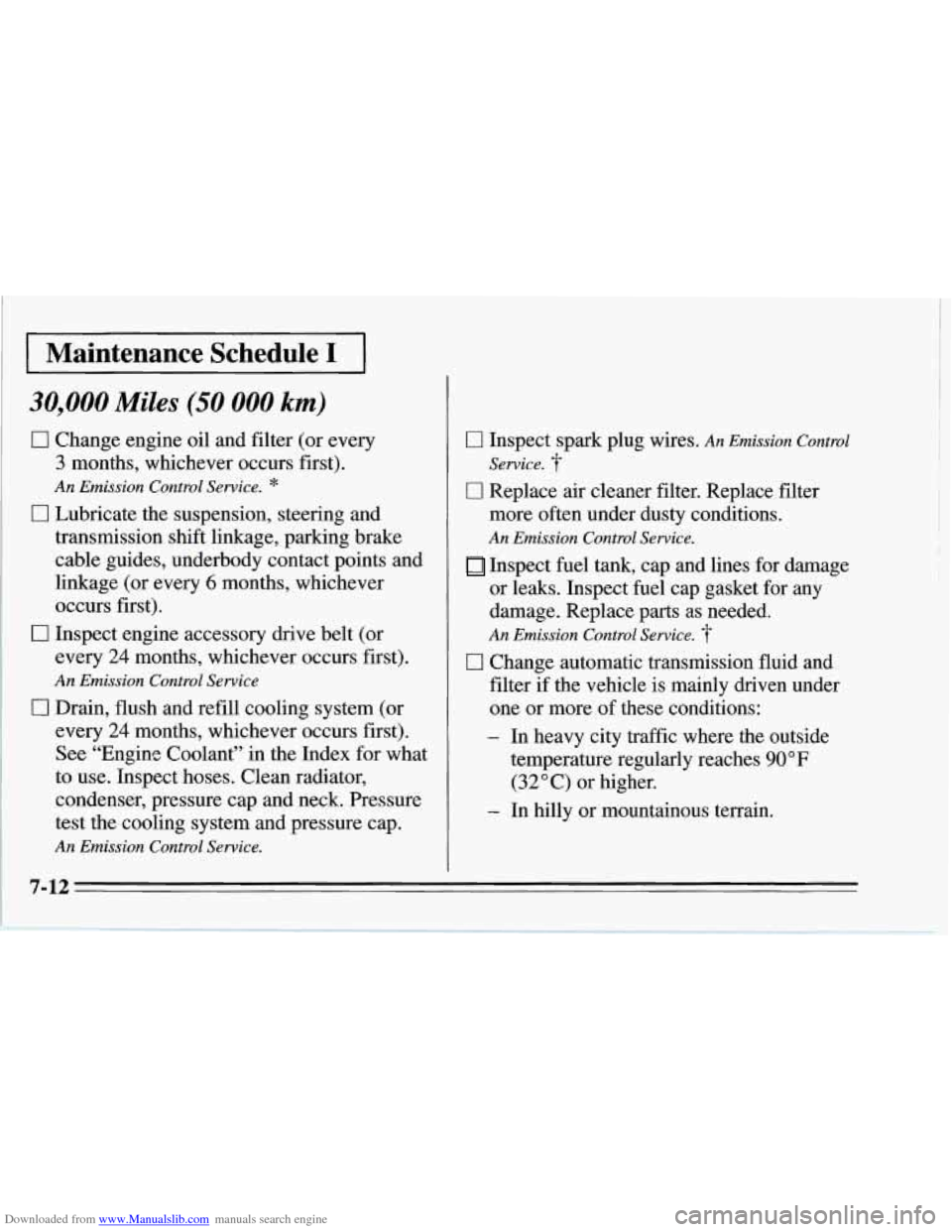
Downloaded from www.Manualslib.com manuals search engine Maintenance Schedule I
30,000 Miles (50 000 km)
0 Change engine oil and filter (or every [7 Inspect spark plug wires. An Emission Control
3 months, whichever occurs first). Service. -f-
An Emission Control Service. * [7 Replace air cleaner filter. Replace filter
17 Lubricate the suspension, steering and more often under dusty conditions.
transmission shift linkage, parking brake
An Emission Control Service.
cable guides, underbody contact Points and Inspect fuel tank, cap and lines for damage
linkage (or every
6 months, whichever or leaks. Inspect fuel cap gasket for any
occurs first). damage. Replace parts as needed.
every
24 months, whichever occurs first). 0 Change automatic transmission fluid and
An Emission Control Service filter if the vehicle is mainly driven under
every
24 months, whichever occurs first). - In heavy city traffic where the outside
See “Engine Coolant” in the Index for what temperature regularly reaches 90 O F
to use. Inspect hoses. Clean radiator, (32 O C) or higher.
condenser, pressure cap and neck. Pressure
test the cooling system and pressure cap.
0 Inspect engine accessory drive belt (or An Emission Control Service. -f-
0 Drain, flush and refill cooling system (or one or more of these conditions:
- In hilly or mountainous terrain.
An Emission Control Service.
7-12
Page 330 of 386
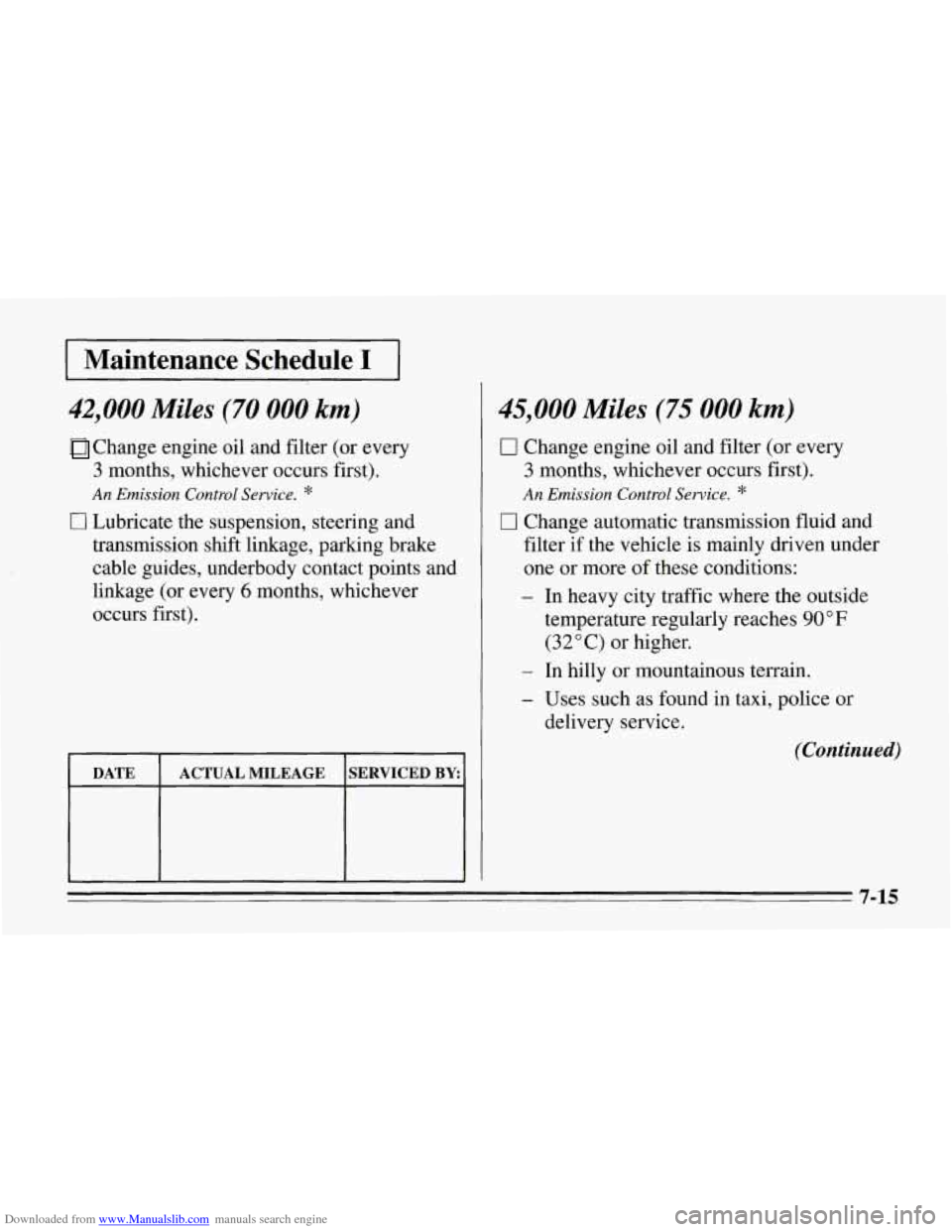
Downloaded from www.Manualslib.com manuals search engine I Maintenance Schedule I 1
42,000 Miles (70 000 km)
Change engine oil and filter (or every
3 months, whichever occurs first).
0 Lubricate the suspension, steering and
An Emission Control Service. *
transmission shift linkage, parlung brake
cable guides, underbody contact points and
linkage (or every
6 months, whichever
occurs first).
DATE
SERVICED BY: ACTUAL MILEAGE
45,000 Miles (75 000 km)
0 Change engine oil and filter (or every
3 months, whichever occurs first).
An Emission Control Service. *
0 Change automatic transmission fluid and
filter
if the vehicle is mainly driven under
one or more of these conditions:
- In heavy city traffic where the outside
temperature regularly reaches
90 OF
(32°C) or higher.
- In hilly or mountainous terrain.
- Uses such as found in taxi, police or
delivery service.
(Continued)
7-15
Page 331 of 386
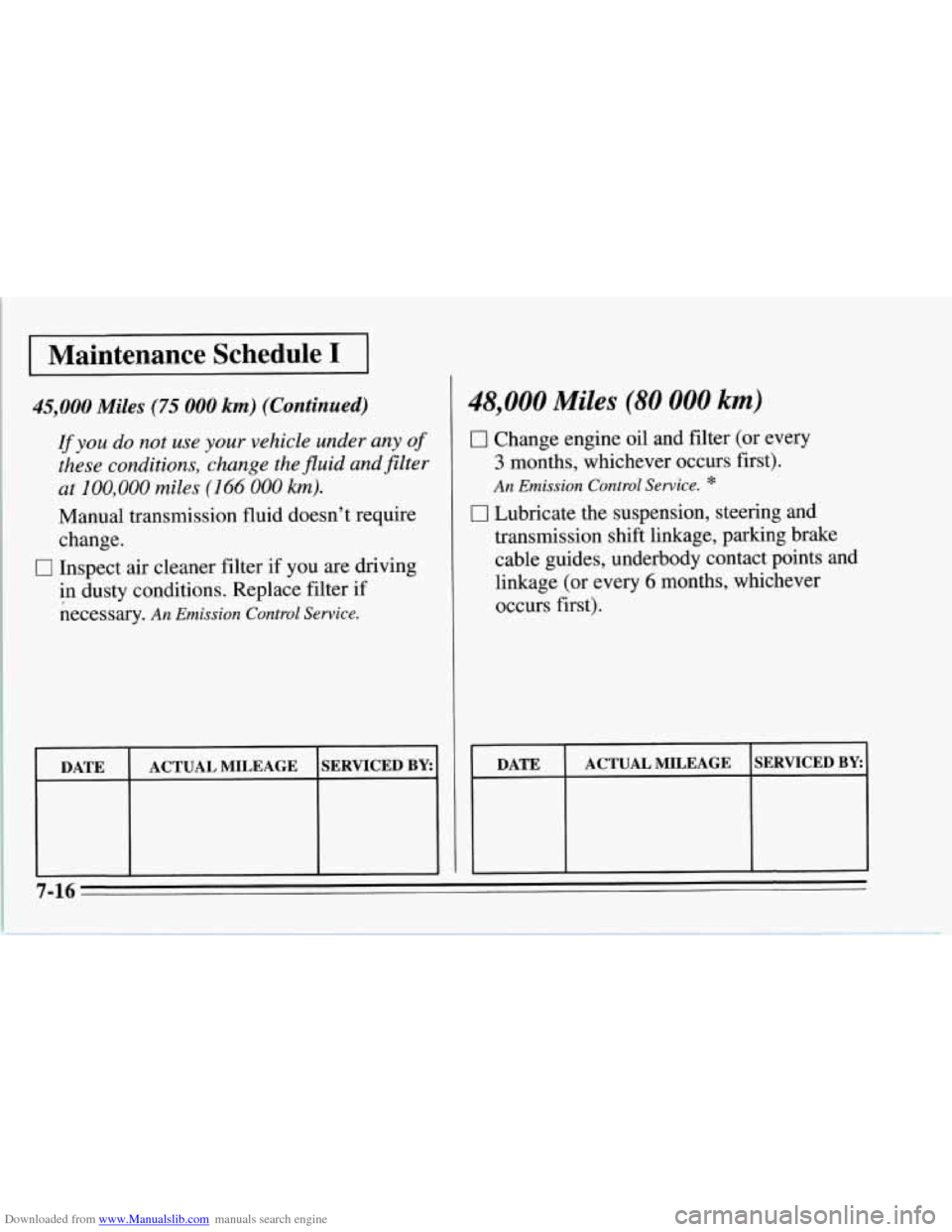
Downloaded from www.Manualslib.com manuals search engine Maintenance Schedule I
45,000 Miles (75 000 km) (Continued)
If you do not use your vehicle under any of
these conditions, change the fluid and filter
at
100,000 miles (I 66 000 km).
Manual transmission fluid doesn't require
change.
0 Inspect air cleaner filter if you are driving
in
4 dusty conditions. Replace filter if
necessary.
An Emission Control Service.
I DATE I ACTUAL MILEAGE SERVICED BY: I
48,000 Miles (80 000 km)
0 Change engine oil and filter (or every
3 months, whichever occurs first).
An Emission Control Service. *
0 Lubricate the suspension, steering and
transmission shift linkage, parking brake
cable guides, underbody contact points and
linkage (or every
6 months, whichever
occurs first).
DATE ACTUAL MILEAGE SERVICED BY:
7-16